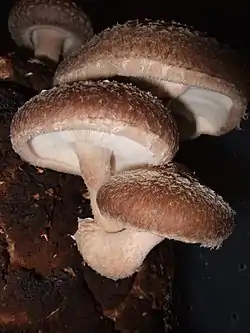椎茸
Japanese
| Kanji in this term | |
|---|---|
| 椎 | 茸 |
| しい Grade: S |
たけ Jinmeiyō |
| kun’yomi | |
| Alternative spelling |
|---|
| シイタケ |
Etymology
Compound of 椎 (shī, “shii or chinquapin tree”) + 茸 (take, “mushroom”), as the mushroom is typically found on logs from the shii or chinquapin tree.[1][2][3]
First cited to 1419.[1]
Noun
椎茸 • (shītake) ←しひたけ (sifitake)?
- [from 1419] shiitake, a type of edible mushroom (Lentinula edodes)
- Synonym: 香蕈 (kōtake)
Usage notes
As with many terms that name organisms, this term is often spelled in katakana, especially in biological contexts (where katakana is customary), as シイタケ.
Descendants
- → English: shiitake
References
- “椎茸”, in 日本国語大辞典 (Nihon Kokugo Daijiten, “Nihon Kokugo Daijiten”) (in Japanese), 2nd edition, Tōkyō: Shogakukan, 2000, →ISBN
- “椎茸”, in デジタル大辞泉 (Dejitaru Daijisen) (in Japanese), Tōkyō: Shogakukan, updated roughly every four months
- 2006, 大辞林 (Daijirin), Third Edition (in Japanese), Tōkyō: Sanseidō, →ISBN
- 1998, NHK日本語発音アクセント辞典 (NHK Japanese Pronunciation Accent Dictionary) (in Japanese), Tōkyō: NHK, →ISBN
- 1997, 新明解国語辞典 (Shin Meikai Kokugo Jiten), Fifth Edition (in Japanese), Tōkyō: Sanseidō, →ISBN
This article is issued from Wiktionary. The text is licensed under Creative Commons - Attribution - Sharealike. Additional terms may apply for the media files.
